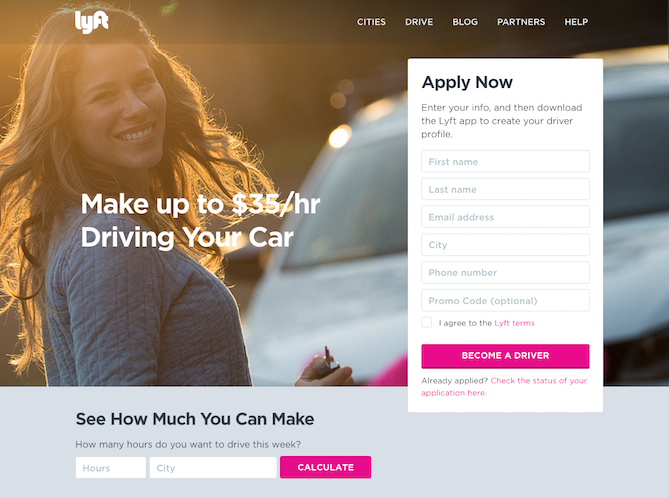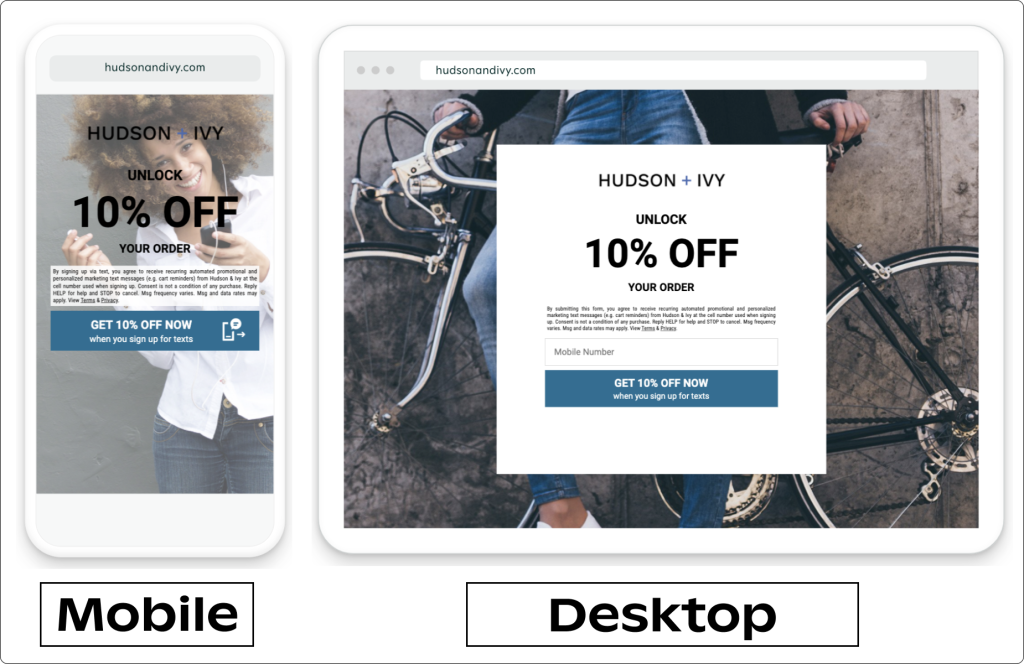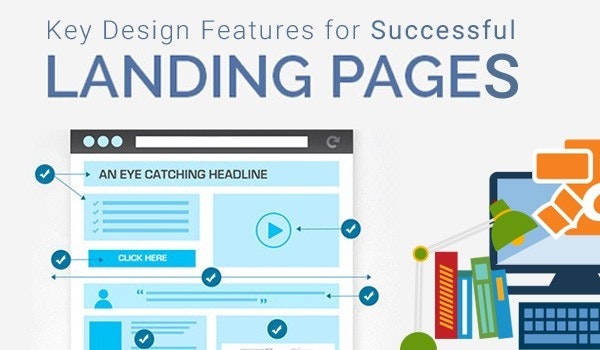What is a Landing Page?
A landing page is any web page that a consumer can land on, but in the marketing realm, it’s usually a standalone page, distinct from your homepage or any other page, that serves a single and focused purpose. A landing page is a follow-up to any promises that you’ve made in your content. Essentially, it’s the next step toward a visitor becoming a customer. Your landing page lets you make a trade, some sort of special offer, a piece of information, or a deal, in return for providing contact information. Landing pages can be click-through, leading to another page, such as your e-commerce site, or lead generation based. Lead generation landing pages typically offer items like an eBook, free trial, contest entry, or webinar registration in return for the submission of contact information. A good landing page will do its job by convincing a potential customer that it’s worth it to provide personal details in exchange for whatever you have to offer. Landing pages can be found through a general search or via your company website, increasing the likelihood that a potential customer will end up there. There’s no need to have just one landing page or even just one landing page at a time. In fact, experts in the marketing world probably suggest that you maintain multiple landing pages targeted toward segmented customer populations.

The key difference between a homepage and a landing page.
Below we’ve got a homepage and a landing page laid out side by side. See how the homepage has tons of links and the landing page has only one? That’s pretty typical. While the homepage has dozens of potential distractions—you can basically call ’em “leaks” instead of links—the landing page is super focused. Having fewer links on your landing page increases conversions, as there are fewer tantalizing clickables that’ll carry visitors away from the call to action. That’s why expert marketers always use a dedicated landing page as the destination of their traffic. Sure, the homepage looks amazing. It shows off the brand, lets people explore a range of products, and offers additional info about the company and its values. From here, a visitor can go anywhere—apply for a job, read some press releases, review the terms of service, post on the community boards, etc. But they won’t necessarily make a purchase. And that’s the point. The landing page for this customer serves a completely different purpose. Paired with super slick ads that promote a single offer, everything about it works hard to turn these visitors into customers. It’s doing a better job to convert the traffic the brand’s already getting. That’s the power of landing pages!I If you want to dive further into the differences between homepages and landing pages and which situations they’re best suited for you. Check out this blog post Unleashing the Potential: How to Boost Shopify Store Conversion Rates and Skyrocket Sales.

What are the different types of landing pages?
You’ll see a lot of variation out there depending on the specifics of the business and whether you’re looking for leads, signups, or sales, but here are the main types of pages you’ll see: Lead generation landing pages: Also called “lead gen pages,” “lead capture pages,” or squeeze pages, these use a form as their call to action. This form almost always collects lead data, like the names and email addresses of visitors. B2B marketers and companies selling high-ticket items use this type of landing page to build a list of prospective customers. They sometimes offer something free, like an ebook or webinar, in exchange for contact info. Ecommerce brands can also use these pages for list-building, or offering free shipping or special deals, too. Some examples of lead gen landing pages include: Clickthrough landing pages: Frequently used by ecommerce and SaaS (software-as-a-service) marketers, clickthrough pages go straight for sales or subscription. Usually, they have a simple button as the call to action that sends the visitor into the checkout flow or completes a transaction.

What are the key elements of a good landing page?
To design a landing page that effectively increases online conversion rates, one should focus on creating an attention-grabbing headline, using clear and concise language, incorporating appealing visual elements, ensuring a user-friendly layout with intuitive navigation, including compelling call-to-action buttons, optimizing page loading speed, conducting A/B testing to optimize performance, and continuously analyzing and improving the page based on user behavior and feedback.
To incorporate attention-grabbing headlines in your landing page, consider using catchy and specific language, highlighting benefits, evoking intrigue, keeping them short and concise, and using strong action verbs. Further incorporating appealing visual elements in a landing page involves techniques such as using high-quality images, choosing a visually pleasing color scheme, utilizing whitespace effectively, employing eye-catching typography, incorporating interactive elements, and ensuring overall visual consistency to create an engaging and attractive user experience. Further to create a landing page with a user-friendly layout and intuitive navigation, you need to carefully design the interface, prioritize important content, use clear and concise headings, incorporate intuitive menus and buttons, optimize for mobile devices, and ensure a seamless user experience.
To create a landing page with compelling call-to-action buttons, focus on clear and concise messaging, use visually appealing design elements, strategically position the call-to-action buttons, ensure they have strong and persuasive copy, keep the form fields minimal and easy to fill, optimize the page load speed, and conduct A/B testing for continuous improvement. A/B testing can be conducted to optimize the performance of a landing page by creating two versions of the page with a single difference, randomly splitting the audience into two groups, showing each group one version, measuring the performance metrics, and determining the version that performs better. Do read this blog post Boost Sales Instantly: Display Top Ranking Customers with Real-Time Popups on Your Ecommerce Store

Top 10 Elements to design a landing page that converts.
There are several essential elements that make a good landing page. These elements are designed to capture the attention of the visitors, provide them with the necessary information, and encourage them to take action. Here are the key elements of a good landing page:
1. Attention-Grabbing Headline: A compelling headline that clearly states the value proposition or offers a solution to a problem will grab the visitor’s attention and entice them to stay on the page.
2. Clear and Concise Message: The landing page should have a clear and concise message that communicates the benefits of the product or service. Avoid using jargon or complex language; instead, focus on communicating the value in a simple and easy-to-understand manner.
3. Engaging Visuals: High-quality and relevant visuals such as images, videos, or infographics can help make the page more engaging and visually appealing. Visuals should be used strategically to support the message and highlight the key points.
4. Call to Action (CTA): The landing page should have a prominent and compelling call to action that tells visitors what action they should take next. The CTA should be clear, visually distinct, and use actionable language, such as “Get started now” or “Sign up for a free trial.”
5. Trust indicators: Including trust indicators such as customer testimonials, reviews, case studies, or trust badges can help build credibility and trust with visitors. These elements reassure potential customers that others have had positive experiences and that the product or service is reliable.
6. Minimalist Design: A clean and minimalist design that eliminates distractions and focuses on the core message is crucial for a good landing page. Remove unnecessary elements that don’t contribute to the main goal, and ensure that the page is easy to navigate and visually appealing.
7. Mobile Optimization: With the increasing use of mobile devices, it is essential to optimize the landing page for mobile users. Ensure that the page is responsive, loads quickly, and is easy to navigate on various screen sizes.
8. Social Proof: Including social proof such as customer testimonials, user reviews, or the number of satisfied customers can help build trust and credibility. Social proof demonstrates that others have had positive experiences with the product or service.
9. Accessible Contact Information: Display contact information, including email addresses or phone numbers, so that visitors can easily get in touch with any questions or concerns. This helps build trust and shows that there is a real person behind the landing page.
10. A/B Testing: Continuously testing and optimizing the landing page elements such as headline, CTA, visuals, or layout is essential for improving conversions and overall performance. A/B testing allows you to experiment and make data-driven decisions to achieve better results.
By incorporating these essential elements, a good landing page can effectively capture leads, convert visitors into customers, and ultimately help achieve your business goals. This post is must read Unlock Your Ecommerce Sales Potential with Social Proof Popups

Boosting Online Conversion Rates: The Ultimate Guide to Using Social Proof on Landing Pages
To enhance the online conversion rates of a landing page through the implementation of social proof, various strategies such as using testimonials, reviews, case studies, endorsements, social media engagement, and influencer partnerships should be employed. WebsitesToolz is a social proof tool with 24 different popups and widgets for every landing page, online business or ecommerce store.
To boost online conversion rates of a landing page using social proof, you can:
- Display customer testimonials and reviews.
- Showcase social media followers and engagement.
- Highlight endorsements from influencers or industry experts.
- Implement trust badges and certifications.
- Use real-time activity notifications.
- Offer social sharing options to encourage user-generated content.
Step 1: Understand the Importance of Social Proof – Social proof is a psychological phenomenon where people rely on the actions and opinions of others to determine their own behavior. – It acts as a powerful tool in influencing decision making and can significantly impact conversion rates on your landing page.
Step 2: Identify Your Target Audience – Before implementing social proof strategies, it’s crucial to understand who your target audience is. – Identify their needs, preferences, and pain points to tailor your social proof accordingly.
Step 3: Collect Testimonials and Reviews – Reach out to satisfied customers and ask them for testimonials or reviews. – Display these testimonials prominently on your landing page to build trust and credibility.
Step 4: Leverage Influencers and Experts – Partner with influencers or industry experts who align with your brand. – Request them to endorse your product or service and share their positive experiences with their followers.
Step 5: Showcase Customer Success Stories – Highlight real-life success stories of customers who have benefited from your product or service. – Use case studies or customer spotlights to demonstrate the value and results your offering delivers.
Step 6: Display Social Media Mentions and Engagement – Incorporate social media widgets that display the number of followers, likes, shares, and comments on your landing page. – This showcases social proof and creates a sense of popularity and trustworthiness.
Step 7: Implement Trust Seals and Certifications – Display trust seals from reputable organizations or security certifications (e.g., SSL) to assure visitors that their information and transactions are safe.
Step 8: Utilize FOMO (Fear of Missing Out) – Create a sense of urgency and scarcity by showcasing limited-time offers or indicating when stock is running low. – This can trigger the psychological fear of missing out and encourage immediate action.
Step 9: A/B Test Social Proof Elements – Continuously test different social proof elements to determine which ones have the most significant impact on conversion rates. – Experiment with different placements, formats, and types of social proof to find the optimal combination.
Step 10: Monitor and Analyze Results – Use analytics tools to track and analyze the impact of social proof on your conversion rates. – Evaluate what’s working and what’s not to refine your strategies and optimize performance.
By following these steps, you can effectively leverage social proof to boost your landing page conversion rates and drive more successful conversions. Finally do checkout this blog post as well How To Get More Signups For Your Events And Newsletters

